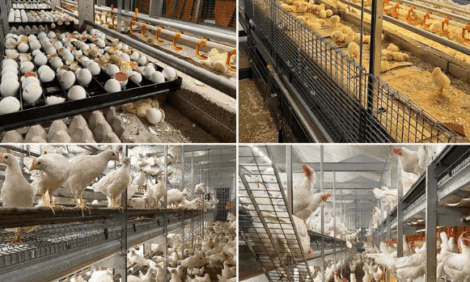



Managing Manure to Improve Air and Water Quality
By Marcel Aillery, Noel Gollehon, Robert Johansson, Jonathan Kaplan, Nigel Key, and Marc Ribaudo, Economic Research service, USDA - Animal waste from confined animal feeding operations is a potential source of air and water quality degradation from evaporation of gases, runoff to surface water, and leaching to ground water. This report assesses the potential economic and environmental tradeoffs between water quality policies and air quality policies that require the animal agriculture sector to take potentially costly measures to abate pollution.
Abstract
A farm-level analysis of hog farms estimates the economic and environmental tradeoffs that occur when policies are designed to address pollutant flows to one environmental medium without considering flows to another medium. A national analysis addresses the broader impacts of coordinated (water and air) policies, including long-term structural adjustments and welfare impacts on both producers and consumers. The report also analyzes the potential implications of adding air quality regulations to existing Clean Water Act regulations in the Chesapeake Bay watershed, where a limited land base increases producers’ costs of meeting manure management requirements.
Contents
- Summary
- Chapter 1—Introduction
- Research Objectives
- Chapter 2—Animal Agriculture and the Environment
- Environmental Impacts of Animal Production
- Policy Regime for Animal Waste
- Ammonia Coefficients Used in This Report
- Chapter 3—Water-Air Tradeoffs at the Farm Level
- Single-Medium Environmental Policies
- Coordinated (Air and Water) Environmental Policies
- Farm-Level Decisions Have National Implications
- Chapter 4—National Effects of Coordinated Manure Management
- Simulating Coordinated Environmental Policies
- What Might We Expect?
- What We Found
- Economic Implications From Market Interactions
- Summary
- Chapter 5—Impact of Spatial Factors on the Costs of Manure Management: A Case Study of the Chesapeake Bay Watershed
- Land Application of Manure With Ammonia-N Reductions
- Conclusions
- Chapter 6—Summary and Implications for Policy and Research
- References
- Web Appendix A—Modeling the Farm Level
- Web Appendix B—USMP Model
- Web Appendix C—Modeling Manure Management in the
- Chesapeake Bay Watershed
- Web Appendix D—Data and Computation Tables
Summary
U.S. environmental laws tend to focus on a single environmental medium
(e.g., Clean Water Act, Clean Air Act, and Endangered Species Act). When a
single pollution source can simultaneously affect more than one environmental
medium, a single-medium approach to pollution control can confound
policymakers concerned with economic efficiency. An uncoordinated set of
policies that independently address different pollution issues can result in
unnecessary and unanticipated economic and environmental costs.
Animal agriculture is facing just this situation. Animal agriculture produces
a variety of pollutants, including organic matter, urea, ammonia, nitrous
oxide, phosphorus, methane, carbon dioxide, pathogens, antibiotics, and
hormones. Regulations to restrict animal farm emissions to the water might
inadvertently increase emissions to the air, and vice versa.
What Is the Issue?
In 2003, EPA introduced revised Clean Water Act regulations to better
protect surface waters from nutrients from concentrated animal feeding
operations (CAFOs). When applying manure to crop or pasture land (the
primary disposal method), CAFOs now must follow a nutrient management
plan that specifies a manure application rate that minimizes the threat to
water quality. The cost to farmers of meeting this requirement can be relatively
high, primarily from moving manure to an adequate land base.
A
logical response by producers operating under a nitrogen-based plan might
be to reduce the nitrogen content of manure spread on fields by enabling
nitrogen to volatilize into the atmosphere from uncovered lagoons or by
applying animal waste to land without incorporating it into the soil. But
doing so also releases ammonia emissions into the air. As animal feeding
operations are the primary source of ammonia in the United States, air
quality regulations might require some States to regulate ammonia emissions
from animal feeding operations.
What Did the Study Find?
Air and water quality regulations would be most cost effective if implemented
simultaneously. This would allow farmers to select the most appropriate
mix of practices that satisfy environmental quality goals while
maximizing net returns. If environmental policies are uncoordinated,
farmers may have to make costly changes to practices more than once
before both environmental goals can be met.
To meet a water quality goal, farmers tend to use practices that increase
ammonia emissions to the air. Similarly, the practices used to meet an air
quality goal would tend to increase nitrogen losses from fields to ground
and surface waters. Meeting both air and water quality goals would likely
cost more than meeting either air or water goals.
Depending on how the air quality regulations are applied, this could have
two impacts on CAFOs and water quality. First, farms identified as CAFOs
might need to increase the amount of land on which they spread manure in
order to continue to meet nutrient application standards. This could be particularly
costly in a region where animal concentrations are high and cropland
available for spreading manure is relatively scarce. For example, requiring
CAFOs in the Chesapeake Bay watershed to control ammonia emissions
would increase producer costs of land-applying manure by $4 million per
year. Failure to account for these costs when developing an ammonia regulation
could lead to the false conclusion that the policy is efficient.
Second, an uncoordinated approach could reduce water quality. If ammonia
reductions were required of both CAFOs and smaller farms, the water
quality benefits from the regulations restricting CAFOs’ nitrogen emissions
might be diluted by increased nutrient applications on the smaller farms,
which have no such nitrogen restrictions. In the Chesapeake Bay watershed,
for example, the nutrient content of manure produced on farms not covered
by a nitrogen application standard would more than double if ammonia
restrictions were applied to all animal feeding operations. This would
increase the risk of nitrogen runoff into the Chesapeake Bay.
Anticipating the different forms and pathways that nitrogen takes can keep
air quality and water quality policies from working at cross purposes. Then,
true solutions—like diet manipulation (to reduce the amount of nitrogen
excreted by animals) or industrial uses of manure—might become clearer.
How Was the Study Conducted?
The study used three separate but related analyses to capture the full range
of economic decisions (and consequences) that result from farmers’ meeting
environmental regulations. Data from the 1998 Agricultural Resources
Management Survey of hog producers were used to estimate the tradeoffs
that occur at the farm level when policies are designed to address pollutant
flows to one environmental medium without considering flows to another
medium. The broader impacts of coordinated policies, including the welfare
impacts on both producers and consumers and regional shifts in production,
were examined with a national model of the agriculture sector that tracks
nitrogen losses to the environment. A case study of the Chesapeake Bay
watershed was used to demonstrate the problems that hypothetical ammonia
reductions would have for farms meeting the CAFO regulations in a region
where land for spreading manure is relatively scarce, and for resource
managers trying to reduce nitrogen loads.
At the heart of all three analyses are nitrogen loss coefficients that are
derived from a mass-balance accounting of nitrogen in manure. These were
obtained from EPA, and enabled us to estimate tradeoffs in nitrogen losses
to the air and nitrogen applied to land as different manure management
practices are employed.
Further Information
To continue reading this article, please click here
Source: U.S. Department of Agriculture, Economic Research Service - September 2005








